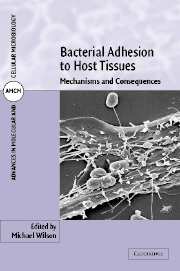Book contents
- Frontmatter
- Contents
- List of contributors
- Preface
- Part I Bacterial adhesins and adhesive structures
- Part II Effect of adhesion on bacterial structure and function
- Part III Consequences of bacterial adhesion for the host
- 10 Adhesion, signal transduction and mucosal inflammation
- 11 Adhesion of oral spirochaetes to host cells and its cytopathogenic consequences
- 12 Interactions between enteropathogenic Escherichia coli and epithelial cells
- 13 Host cell responses to Porphyromonas gingivalis and Actinobacillus actinomycetemcomitans
- Index
- Plate section
10 - Adhesion, signal transduction and mucosal inflammation
Published online by Cambridge University Press: 08 October 2009
- Frontmatter
- Contents
- List of contributors
- Preface
- Part I Bacterial adhesins and adhesive structures
- Part II Effect of adhesion on bacterial structure and function
- Part III Consequences of bacterial adhesion for the host
- 10 Adhesion, signal transduction and mucosal inflammation
- 11 Adhesion of oral spirochaetes to host cells and its cytopathogenic consequences
- 12 Interactions between enteropathogenic Escherichia coli and epithelial cells
- 13 Host cell responses to Porphyromonas gingivalis and Actinobacillus actinomycetemcomitans
- Index
- Plate section
Summary
INTRODUCTION
Mucosal surfaces continue where the skin leaves off, completing the boundaries between the environment and internal tissues. It is to the mucosal barrier that pathogens first attach, and the ensuing molecular interactions determine whether the pathogens will cause infection or if health will be maintained.
The different cell populations in the mucosal barrier are equipped to sense and respond to the molecular contents in the lumen and to translate this molecular information into signals that can reach local or distant tissue sites. Inflammatory cascades are often the first to be activated by bacteria or viruses, and explain many aspects of acute disease. It is not the presence of microbes in the tissues that makes us sick. Vast numbers of bacteria may colonize different sites in the body, and viruses may persist for long periods of time, while the host remains perfectly healthy. It is the host response to the infecting agents that causes the symptoms and tissue damage. Inflammatory mediators thus provide a direct link between the microbe and the host in disease pathogenesis (for a review, see Svanborg et al., 1999).
It is commonly accepted that the most virulent bacteria cause the most severe acute symptoms and long-term effects, but the mechanisms used to trigger acute disease manifestations are less clear. Pathogens elicit the strongest host response, even though members of the indigenous microflora contain many of the same molecules. This is quite puzzling, but at least two factors may explain the difference.
- Type
- Chapter
- Information
- Bacterial Adhesion to Host TissuesMechanisms and Consequences, pp. 223 - 246Publisher: Cambridge University PressPrint publication year: 2002
- 3
- Cited by



